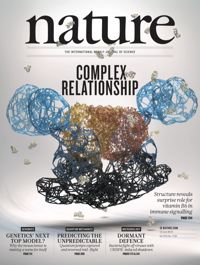《自然》(20190613出版)一周论文导读
翻译 | 唐一尘
Nature, 13 June 2019, Volume 570 Issue 7760
《自然》2019年6月13日,第7760期570卷
古生物Paleontology
Early fungi from the Proterozoic era in Arctic Canada
加拿大北极元古代的早期真菌
▲ 作者:Corentin C.Loron、Camille François、Emmanuelle J. Javaux,etal
▲ 链接:
https://www.nature.com/articles/s41586-019-1217-0
▲ 摘要:
真菌是现代生态系统的关键组成成分,并且与陆地上最早的生命迹象有关。尽管如此,真菌的化石记录一直以来只能追溯至约4亿年前的中古生代。
本研究报告了有机质壁微体化石Ourasphaira giraldae样本,它们保存在加拿大西北地区草湾构造的河口页岩内。
研究人员在样本的细胞壁内鉴定出了有隔菌丝和几丁质,确定O. giraldae的结构为典型的真菌结构。这代表了地质记录中最早的几丁质——形成真菌细胞壁的纤维性物质。
以上发现也将后鞭毛生物(真核生物的一个主要类群,包括动物和真菌)的起源时间大大向前推进至中元古宙时期。
▲ Abstract
Fungi are crucial components of modern ecosystems. They may have had an important role in the colonization of land by eukaryotes, and inthe appearance and success of land plants and metazoans. Nevertheless, fossils that can unambiguously be identified as fungi are absent from the fossil record until the middle of the Palaeozoic era. Here we show, using morphological, ultrastructural and spectroscopic analyses, that multicellular organic-walled microfossils preserved in shale of the Grassy Bay Formation (Shaler Supergroup, Arctic Canada), which dates to approximately 1,010–890 million years ago, have a fungal affinity. These microfossils are more than half a billion years older than previously reported unambiguous occurrences of fungi, a date whichis consistent with data from molecular clocks for the emergence of this clade. In extending the fossil record of the fungi, this finding also pushes back the minimum date for the appearance of eukaryotic crown group Opisthokonta, which comprises metazoans, fungi and their protist relatives.
Palaeo-Eskimo genetic ancestry and the peopling of Chukotka and North America
古爱斯基摩人的遗传祖先和楚科奇人与北美人的关系
▲ 作者:Pavel Flegontov、N. Ezgi Altınışık、Stephan Schiffels,etal
▲ 链接:
https://www.nature.com/articles/s41586-019-1251-y
▲ 摘要:
约5000年前,古爱斯基摩人成为了美洲北极广阔地区的首批定居者,1000年前左右,现代因纽特人和尤皮克人的祖先陆续抵达,并从很大程度上取代了古爱斯基摩人。
不过,古爱斯基摩人和美洲土著人、因纽特人、尤皮克人和阿留申人这些群体之间的亲缘关系一直未得到确定。
本论文分析了来自美洲北极和西伯利亚的48例古代个体的基因组数据,这些地区包括楚科奇、东西伯利亚、阿留申群岛、阿拉斯加和加拿大北极。
此外,研究人员还报道了现代阿拉斯加伊努皮亚特人以及西西伯利亚人群的数据。
分析显示,北美人群历史主要来自于古爱斯基摩人与首批美洲人之间的基因流,这也是以爱斯基摩—阿留申语系和纳-德内语为母语人群的起源。
▲ Abstract
Much of the American Arctic was first settled 5,000 years ago, by groups of people known as Palaeo-Eskimos. They were subsequently joined and largely displaced around 1,000 years ago by ancestors of the present-day Inuit and Yup’ik. The genetic relationship between Palaeo-Eskimos and Native American, Inuit, Yup’ik and Aleut populations remains uncertain. Here we present genomic data for 48 ancient individuals from Chukotka, East Siberia, the Aleutian Islands, Alaska, and the Canadian Arctic. We co-analyse these data with data from present-day Alaskan Iñupiat and West Siberian populations and published genomes. Using methods based on rare-allele and haplotype sharing, as well as established techniques, we show that Palaeo-Eskimo-related ancestry is ubiquitous among people who speak Na-Dene and Eskimo–Aleut languages. We develop a comprehensive model for the Holocene peopling events of Chukotka and North America, and show that Na-Dene-speaking peoples, people of the Aleutian Islands, and Yup’ik and Inuit across the Arctic region all share ancestry from a single Palaeo-Eskimo-related Siberian source.
The population history of northeastern Siberia since the Pleistocene
西伯利亚东北部自更新世以来的人口历史
▲ 作者:Martin Sikora、Vladimir V. Pitulko、Eske Willerslev,et al
▲ 链接:
https://www.nature.com/articles/s41586-019-1279-z
▲ 摘要:
西伯利亚东北部已经有4万多年的人类居住历史,但人们对其深厚的人口历史仍知之甚少。
本研究报道了西伯利亚东北部(今俄罗斯远东地区)的34例古基因组,这些基因组来自距今31000年至600年前。虽然人类在这一地区居住已有4万多年,但其深度人群历史却鲜为人知。
研究人员记录下了这一时期的复杂人群动态,包括至少3次主要迁移事件:此前不为人知的旧石器时代古代北西伯利亚人群的首次抵达,这一人群也是早期西欧亚狩猎采集者的远亲;东亚人群的抵达以及随后诞生的古代古西伯利亚人和美洲土著人;名为新西伯利亚人的东亚人群的全新世迁移,许多当代西伯利亚人都是他们的后裔。
▲ Abstract
Northeastern Siberia has been inhabited by humans for more than 40,000 years but its deep population history remains poorly understood. Here we investigate the late Pleistocene population history of northeastern Siberia through analyses of 34 newly recovered ancient genomes that date to between 31,000 and 600 years ago. We document complex population dynamics during this period, including at least three major migration events: an initial peopling by a previously unknown Palaeolithic population of ‘Ancient North Siberians’ who are distantly related to early West Eurasian hunter-gatherers; the arrival of East Asian-related peoples, which gave rise to‘Ancient Palaeo-Siberians’ who are closely related to contemporary communities from far-northeastern Siberia (such as the Koryaks), as well as Native Americans; and a Holocene migration of other East Asian-related peoples, who we name ‘Neo-Siberians’, and from whom many contemporary Siberians are descended. Each of these population expansions largely replaced the earlier inhabitants, and ultimately generated the mosaic genetic make-up of contemporary peoples who inhabit a vast area across northern Eurasia and the Americas.
健康Health
Mapping HIV prevalence in sub-Saharan Africa between 2000 and 2017
绘制2000年至2017年撒哈拉以南非洲地区艾滋病病毒流行情况地图
▲ 作者:Laura Dwyer-Lindgren、Michael A.Cork、Simon I. Hay,et al
▲ 链接:
https://www.nature.com/articles/s41586-019-1200-9
▲ 摘要:
尽管治疗方法有了进步,但是艾滋病仍是撒哈拉以南非洲的主要疾病负担来源,而且是该区域最常见的死因。拥有更加详细的关于艾滋病病毒(HIV)流行率差异的信息,或有助于预防和治疗HIV感染。
本研究全面分析了2000年至2017年47个撒哈拉以南非洲国家的HIV流行率。所用数据都来自调查和保健诊所,这些数据提供了HIV在15~49岁成人群体中的流行率估算值。
研究人员比较了每个国家各行政区域之间的流行率以及5x5千米网格区域之间的流行率情况。
结果显示国家之间和各国国内不同区域都存在明显的差异——HIV整体流行率较低的国家,其国内也有局部区域呈现出较高的HIV流行率。在其中15个国家,国家层面的HIV流行率在2000年至2017年之间上升了,不过在局部区域这种趋势存在差异。
该研究或有助于采用精准干预手段,控制撒哈拉以南非洲的HIV感染。
▲ Abstract
HIV/AIDS is a leading cause of disease burden in sub-Saharan Africa. Existing evidence has demonstrated that there is substantial local variation in the prevalence of HIV; however, subnational variation has not been investigated at a high spatial resolution across the continent. Here we explore within-country variation at a 5 × 5-km resolution in sub-Saharan Africa by estimating the prevalence of HIV among adults (aged 15–49 years) and the corresponding number of people living with HIV from 2000 to 2017. Our analysis reveals substantial within-country variation in the prevalence of HIV through out sub-Saharan Africa and local differences in both the direction and rate of change in HIV prevalence between 2000 and 2017, highlighting the degree to which important local differences are masked when examining trends at the country level. These fine-scale estimates of HIV prevalence across space and time provide an important tool for precisely targeting the interventions that are necessary to bringing HIV infections under control in sub-Saharan Africa.
Metabolic control of BRISC–SHMT2 assembly regulates immune signalling
BRISC–SHMT2组装的代谢调控控制免疫信号
▲ 作者:Miriam Walden、Lei Tian、Elton Zeqiraj,etal
▲ 链接:
https://www.nature.com/articles/s41586-019-1232-1
▲ 摘要:
免疫细胞及其被称为细胞因子的信号化合物的过度生产,会引发过度炎症,导致大量组织损伤。一种参与修复受损DNA的酶也存在于一个叫做BRISC的单独复合物中,用来调节免疫信号。
研究人员利用低温电子显微镜计算出了分子复合物的结构。他们的发现揭示了一种有趣的分子机制,将BRISC与一种参与代谢的酶——丝氨酸羟甲基转移酶2 (SHMT2)联系起来。
在被激活后,SHMT2引导对基本身体功能至关重要的反应,如蛋白质和DNA的构建块。
研究小组发现SHMT2还通过与BRISC复合物的相互作用诱导免疫细胞释放细胞因子。破坏BRISC-SHMT2结合区域的突变干扰了炎症的侵袭,这或有助于开发狼疮药物新靶点。
▲ Abstract
Serine hydroxymethyltransferase 2 (SHMT2) regulates one-carbon transfer reactions that are essential for amino acid and nucleotide metabolism, and uses pyridoxal-5′-phosphate (PLP) as a cofactor. Apo SHMT2 exists as a dimer with unknown functions, whereas PLP binding stabilizes the active tetrameric state. SHMT2 also promotes inflammatory cytokine signallingby interacting with the deubiquitylating BRCC36 isopeptidase complex (BRISC), although it is unclear whether this function relates to metabolism. Here we present the cryo-electron microscopy structure of the human BRISC–SHMT2 complexat a resolution of 3.8 Å. BRISC is a U-shaped dimer of four subunits, and SHMT2 sterically blocks the BRCC36 active site and inhibits deubiquitylase activity. Only the inactive SHMT2 dimer—and not the active PLP-bound tetramer—binds and inhibits BRISC. Mutations in BRISC that disrupt SHMT2 binding impair type I interferon signalling in response to inflammatory stimuli. Intracellular levels of PLP regulate the interaction between BRISC and SHMT2, as well as inflammatory cytokine responses. These data reveal amechanism in which metabolites regulate deubiquitylase activity and inflammatory signalling.
物理Physics
Elastic colloidal monopoles and reconfigurable self-assembly in liquid crystals
液晶中的弹性胶体磁单极子及可重构自组装
▲ 作者:Ye Yuan、Qingkun Liu、Bohdan Senyuk、Ivan I. Smalyukh
▲ 链接:
https://www.nature.com/articles/s41586-019-1247-7
▲ 摘要:
类磁单极子静电相互作用在生物学和凝聚态物质中是普遍存在的,但它们往往被反离子屏蔽,不能从吸引态转变为排斥态。
在胶体学中,主要目标是开发胶体粒子,模拟和超越原子和分子组装的多样性和长度尺度,带静电粒子不能改变其表面电荷的符号,也不能从单极转变为高阶多极。
本研究用非结构光演示了这些胶体粒子从单极到四极的重排,它类似于原子在基态和各种激发态之间的驱动。
研究人员证明了弹性磁单极子的符号是可以被转换的,并且与静电学中不同,同性电荷的磁单极子相互吸引,而异性电荷的磁单极子相互排斥。研究还证明了这些胶体粒子的非平衡动态组装。
▲ Abstract
Monopole-like electrostatic interactions are ubiquitous in biology and condensed matter, but they are often screened by counter-ions and cannot be switched from attractive to repulsive. In colloidal science, where the main goal is to develop colloidal particles that mimic and exceed the diversity and length scales of atomic and molecular assembly, electrostatically charged particles cannot change the sign of their surface charge or transform from monopoles to higher-order multipoles. In liquid-crystal colloids, elastic interactions between particlesarise to minimize the free energy associated with elastic distortions in the long-range alignment of rod-like molecules around the particles. In dipolar,quadrupolar and hexadecapolar nematic colloids, the symmetries of such elastic distortions mimic both electrostatic multipoles and the outermost occupied electron shells of atoms. Electric and magnetic switching, spontaneous transformations and optical control of elastic multipoles, as well as their interactions with topological defects and surface boundary conditions, have been demonstrated in such colloids. However, it has long been understood that elastic monopoles should relax to uniform or higher-order multipole statesbecause of the elastic torques that they induce. Here we develop nematiccolloids with strong elastic monopole moments and with elastic torques balanced by the optical torques induced by ambient light. We demonstrate the monopole-to-quadrupole reconfiguration of these colloidal particles by unstructured light, which resembles the driving of atoms between the groundstate and various excited states. We show that the sign of the elasticmonopoles can be switched, and that like-charged monopoles attract whereas oppositely charged ones repel, unlike in electrostatics. We also demonstratethe out-of-equilibrium dynamic assembly of these colloidal particles. This diverse and surprising behaviour is explained using a model that considers the balance of the optical and elastic torques that are responsible for the excited-state elastic monopoles and may lead to light-powered active-matter systems and self-assembled nanomachines.
合作事宜:market@stimes.cn
投稿事宜:tougao@stimes.cn








